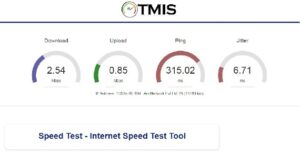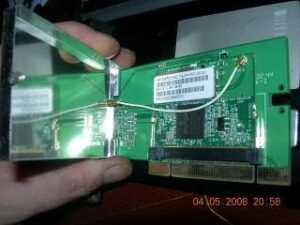The Wi-Fi temperature humidity (or hygrometer) sensor uses an integrated sensor module to monitor the temperature and humidity of the surrounding environment. Since it is a Wi-Fi sensor, it wirelessly transmits the data to the Internet through a Wi-Fi connection.
This type of temperature and humidity sensor can deliver real-time alert information. But it can also monitor the temperature and humidity conditions of all locations via mobile phones. Depending on the type of temperature sensor, you may examine data on the PC via software, mobile applications, computer browsers, or any combination of the three.
- Compatible with major cable internet providers including Xfinity, Spectrum, Cox and more. NOT compatible...
- [Compatibility] 12V Power Supply Adapter Compatible with Netgear, Linksys, Asus,Motorola, Motorola/Arris...
This article sums up the different uses of a Wi-Fi humidity season, its mechanisms, and various types. We also shortlist the best sensors for your requirements and will empower you to make the right choice for your humidity sensor needs.
Wi-Fi Humidity Sensor Mechanism And Types
Humidity sensors detect variations in electrical currents or temperature in the air. To compute the humidity in the air, these Wi-Fi humidity sensors will detect minute changes in the environment.
There are three types of humidity sensors, and all of them have their mechanism by which they calculate the humidity in the air. The three major humidity sensors include capacitive, resistive, and thermal humidity sensors.
Humidity sensors also range in size and capability. Some are available in mobile devices (such as smartphones), while others are built into larger embedded systems (such as air quality monitoring systems). Let us understand how they work by their types.
1. Capacitive Humidity Sensors
A capacitive humidity sensor with a typical range of 5 to 95 percent relHum monitors relative humidity. The sensor is a capacitor composed of two metal electrodes separated by a porous dielectric material. Water vapor can enter this layer, causing the overall capacitance to change.
The relative humidity of a capacitive humidity sensor is measured by sandwiching a thin strip of metal oxide between these two electrodes. The electrical capacity of metal oxide varies with the relative humidity of the environment.
2. Resistive Humidity Sensors
A resistive humidity sensor is also known as a hygristor or an electrical conductivity sensor. This type of Wi-Fi humidity sensor uses the change in resistance measured between two electrodes to calculate relative humidity.
3. Thermal Humidity Sensors
We can measure absolute humidity using thermal conductivity humidity sensors. They do it by estimating the difference in heat conductivity between dry and humid air. Two NTC thermistors are hung from the sensor by thin cables.
Uses Of Wi-Fi Humidity Sensors
Now that we understand the types of humidity sensors, let us delve deeper into the world of Wi-Fi humidity sensors. In this section and further sections, we shall explore the following:
- Why do we need humidity sensors?
- Which humidity sensor is the best for our needs?
- What are the qualities of a good Wi-Fi humidity sensor?
Read on to find out all the functions that a simple Wi-Fi humidity sensor can lend to us and our daily lives:
1. Remote Monitoring and Intelligent Asset Management
- Wi-Fi humidity sensors can alarm us when humidity rises due to rising temperatures. Because of the high humidity range, moisture can enter hardware systems and condense under certain settings. This has the potential to short-circuit expensive electrical components or at the very least produce bogus unexpected connections.
- Changes in moisture content directly influence fabric qualities such as tensile strength, elasticity, fiber diameter, and friction in industries such as textile. We can manage our assets better with the help of these humidity sensors.
- On the other hand, low humidity can cause seals and other protective elements to dry up. It can also increase the likelihood of static electricity discharge, which can be disastrous for delicate electrical circuits.
2. Smart Building Management Systems
- Humidity sensors allow us to maintain perfect conditions in our buildings and apartments. They manage heating, ventilation, and air conditioning systems in homes and businesses.
- They’re employed in industrial facilities, hospitals, museums, greenhouses, weather stations, and any other location where moisture could potentially be an issue. For instance, when the humidity in the air is too high or too low, it promotes the development and spread of certain germs and viruses.
3. IoT And Sensors At Home
- Moisture measurement is helpful in plants to determine when their soil is moist and fed for development. The control may be accomplished with a water pump, which can be activated whenever the sensor detects a fall in humidity and will cease pumping once it reaches the optimal humidity.
- Similarly, house humidity sensors can assist homeowners in identifying regions of high humidity in the home. These sensors alert us into taking action to boost ventilation or lower humidity through optimal ventilation.
How To Select The Best Wi-Fi Humidity Sensors?
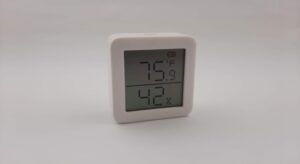
Now, to select the best sensor for our needs, we judge the utility of Wi-Fi humidity sensors using the following parameters:
● Range
In most cases, temperature and humidity measurement and management do not necessitate complete humidity (0-100 percent RH) monitoring. The broader the range, the higher the price; simply select the range that matches your project’s requirements.
● Accuracy
The humidity sensor’s most essential metric is its measurement accuracy. The humidity sensor advances a step or even a grade for every percentage point rise.
● Linearity
It displays the voltage variation between the BFSL and the observed output voltage values in relative humidity.
● Response Time
The reaction time is often defined by the time it takes a sensor to climb to 66 percent (rise time) or decrease to 33 percent (fall time) of maximum output voltage—the more responsive, the better.
● Repeatability
The measurements from a sensor must be taken so that they do not vary each time in measuring the same level of humidity. The measurement of drift among measurements of a particular quantity is known as repeatability.
The Best Wi-Fi Humidity Sensors For Your Needs
Now, we know which Wi-Fi humidity sensor might be the best for us. So, ahead, we make your work easier by listing the best sensors (with their pros and cons) money can buy:
1. SensorPush HT1 Temperature and Humidity Smart Sensor
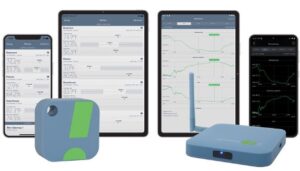
This digital hygrometer is an excellent choice for monitoring humidity levels in your house. This sensor has a 325-foot range through Bluetooth in ideal conditions with no impediments. There is also the option of purchasing a Wi-Fi gateway device to use as a Wi-Fi humidity sensor and getting notifications from anywhere.
The Swiss-made sensor component ensures exact readings. Data is captured at one-minute intervals and saved on the sensor for more than two weeks. When mobile applications are in range, it is automatically delivered to them.
Pros:
- Comes with an accessible price tag
- Humidity range of 0 – 100%
- You can set it up easily, and a battery comes in the box
- The app is also quite simple to use
- When not linked to Bluetooth, the device may save up to 20 days of data
- High precision and dependability
- Light and compact
Cons:
- When the Wi-Fi gateway is added, the price skyrockets
- The Bluetooth range might be limited depending on where the gadget is in the home
2. Temp Stick WiFi Temperature & Humidity Sensor
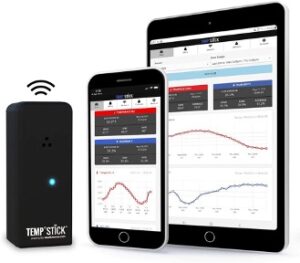
The Temp Stick is a one-of-a-kind monitoring and alarm gadget that requires only an active Wi-Fi connection and two AA batteries (included)! It has unlimited history and remote access features as well.
When an essential change in temperature or humidity is detected, the Temp StickTM Wi-Fi-enabled smart monitor alerts your phone or email. You define the alerts and trigger points. You can also view and edit from any location and at any time!
Pros:
- Hygrometer with extremely high precision
- LED sensor illuminates when the sensor is taking readings
- Internet access through Wi-Fi
- Simple installation
- There are no subscription costs
- The app is simple to use
- Email and phone help are provided at no cost
Cons:
- A little costly as compared to many other Wi-Fi humidity sensors
- Because the lowest reporting interval is 5 minutes, full real-time reporting is not possible
- When employing frequent reporting intervals, battery life is lowered
3. MINGER Govee WiFi Temperature Sensor
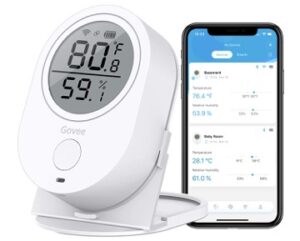
MINGER Govee can be a great Wi-Fi humidity sensor for folks on a budget. This is a Wi-Fi temperature sensor that also doubles up as a hygrometer. And a pretty good one at that!
The Govee Wi-Fi Temperature Sensor is designed to be used indoors and outdoors. It works with iOS and Android. It has a wireless thermometer and a hygrometer, and it can send notifications based on the thresholds you’ve set.
The Govee display unit is approximately 3.0 x 2.5 x 0.9 inches. The front side looks basic and minimal, yet it has a highly visible display for all important sensor data.
Pros:
- It has a built-in temperature sensor
- Compatible with 2.4 GHz Wi-Fi networks
- A one-year warranty is included
- The app is simple to use and has a variety of functionalities as well as online data storage
- Humidity monitoring is supported and accurate
Cons:
- Wi-Fi networks operating at 5 GHz are not supported
- There is no backlight button on this sensor
4. Cigar Oasis Caliber 4R Digital/Analog Hygrometer
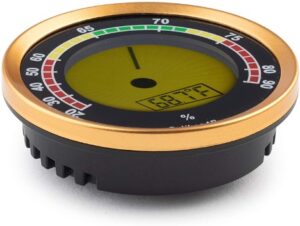
The precision of digital meets the radiance of analog in this Wi-Fi humidity sensor. This beautiful sensor has quickly become a staple because of its looks and practicality. Although there are no remote reporting or alert options, it is a very accurate and functional solution at a reasonable cost.
This is an updated version of the Caliber IV digital with an appealing old analog design. Humidity and temperature measurements, Fahrenheit/Celsius readings, 72-hour high/low & humidity & temperature averages, and gauges ranging from 20 to 90 percent relative humidity (RH) make it all the more worth it.
Pros:
- The advanced humidity sensor has an accuracy of +/- 1%
- User-recalibration is possible
- The design is sharp and circular
- It is color-coded to make reading easier
- It also tells us humidity and temperature averages
- Its magnetic mount is secure
Cons:
- No remote alerting option
- The display must be read at the correct angle; otherwise, it will be difficult to read
- There are no alternatives for remote reporting or alerts
5. AcuRite 00613 Digital Hygrometer & Indoor Thermometer
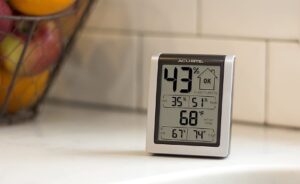
The AcuRite 00613 Indoor Humidity Monitor is an all-in-one digital temperature and humidity gauge. It will provide you with a complete view of your indoor environment. You can also obtain humidity monitoring and correct temperature with an easy-to-read display.
This AcuRite small Wi-Fi humidity sensor is convenient to set anywhere in the house or take on the move if necessary. It contains a clip for mounting, and the clasp may be locked outward to serve as a kickstand. Furthermore, the magnetic back allows for even more mounting choices.
Pros:
- Displays the high and low temperatures and humidity daily
- There are two temperature units available: Fahrenheit and Celsius
- It is simple to install, hang, or prop up
Cons:
- There is no backlight, so it will be difficult to see at night
- No remote monitoring
- Wireless signal has a limited range
6. Extech 445815 Hygro-Thermometer Humidity Alert with Dew Point
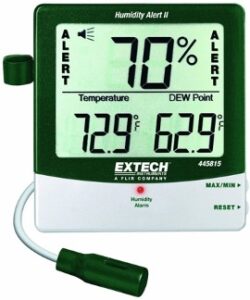
This Humidity Meter with an alarm and remote probe has a big three-digit display showing relative humidity, temperature, and dew point. It has a built-in stand for sitting on a desk, but it may also be wall-mounted with the provided bracket. An audio and visual alert is sent when the humidity level rises or falls above or below the adjustable setpoint.
The maximum and lowest values are also saved by the meter. For measuring behind walls, the remote probe reaches 18 inches. It is ideal for use in damp places where mold might grow.
Pros:
- The display is large and simple to read
- Remote probe for difficult-to-reach regions
- Temperature, humidity, and dew point are all measured
Cons:
- If you don’t require the remote probe, you get less capability for the money
- Minimum and maximum readings are used to restrict data storage
Final Word
Select the best Wi-Fi humidity sensor as per your needs of accuracy, reliability, mounting, or remote alert. Your homes, assets, and smart factories and buildings can be a little more secure with humidity control with the help of these devices.




